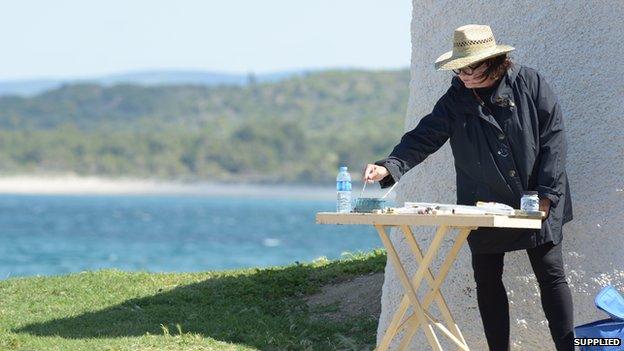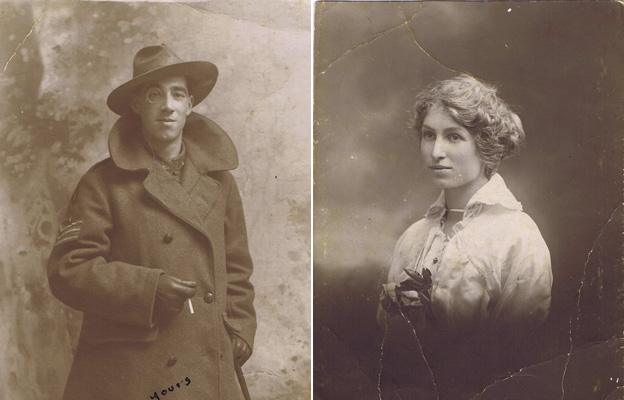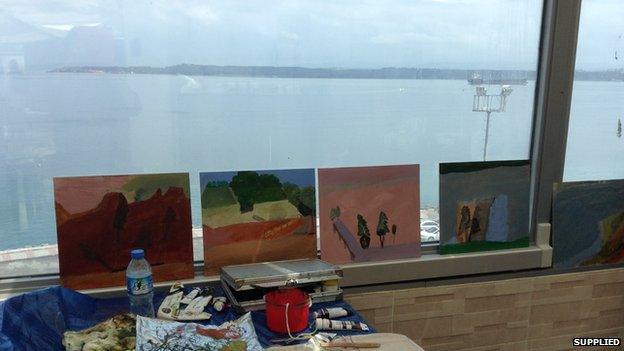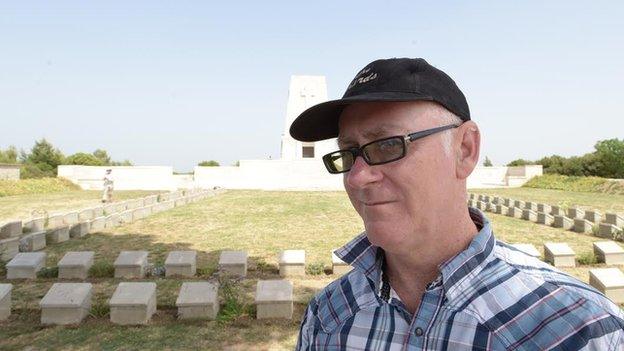Artists bring personal touch to Gallipoli exhibition
- Published
Artist Idris Murphy reads from his grandfather's letters and talks about how they inspired him (Film by Rebecca Leaver)
Anzac Day - 25 April - is probably Australia's most important national occasion. It marks the anniversary of the first campaign that led to major casualties for Australian and New Zealand forces during World War One and commemorates all the conflicts that followed. This year marks the centenary of that first bloody battle on the shores of Gallipoli.
In September 1915, as fighting raged in the trenches of Gallipoli on Turkey's northwest coast, an impromptu ceasefire saw a remarkable act of friendship between enemies.
"We threw some tinned beef and jam over to [the Turks], they soon raked them in to their trenches, and in return they threw tobacco and cigarette papers," wrote Australian soldier Idris Charles Pike in a letter to his sweetheart Violet.
Words, as well as gifts, were exchanged. The Turks wrote a note in French thanking the Australians for the goods. They signed off: "Your soldier Friends Turks."
A century later, Pike's letters to the woman who would become his wife inspired a group of Australian and New Zealand artists to visit Gallipoli - making a pilgrimage that in recent years has become almost a rite of passage for many of their countrymen.

Sixteen artists travelled to Gallipoli for an upcoming exhibition: Your Friend the Enemy
Gallipoli, a major allied failure in the First World War, looms large in Australia and New Zealand's collective memory. It is seen by many as a key event in the emergence of national identities for both countries.
The result of two trips in 2013 and 2014, where the 16 artists painted on site, is a major exhibition opening this month in Sydney before it travels the country. Your Friend The Enemy marks 100 years since the Australian and New Zealand Army Corps (Anzac) landed at Gallipoli on 25 April 1915.
"It was a bit of a shock," recalls Idris Murphy, one of the artists and the grandson of Pike, of his time on the rocky peninsula that juts into the Aegean Sea.
"How beautiful it was, how sad it was. You are standing on your forebear's bones."
Hidden love letters
Murphy's connection to Gallipoli first developed when he saw a book of photographs of Australian soldiers who had fought in WWI. Among the hundreds of anonymous faces in the book, the artist recognised his grandfather.
The photo had been taken in the village of Vignacourt, two hours north of Paris. Pike's identity was later confirmed by the Australian War Memorial.
After the death of his mother in 2012, squirreled away among the family papers Murphy found 160 letters his grandfather had written to his sweetheart Violet.
"They are love letters. Hidden for the best part of 90 odd years, packed away in a box," says Murphy.
"No one ever talked about the war. When my grandfather came back all they wanted to do was forget. He didn't even open his medals."

Australian soldier Idris Charlie Pike wrote to his sweetheart Violet from Gallipoli

The artists painted on site in Turkey
Pike, who was born in London and emigrated to Australia as a teen, met Violet at Sunday school. At age 19, he enlisted in a war that would change them both. From Gallipoli he wrote to her: "I simply hunger for your letters. I am not the fun and easy Charlie you used to know."
The young soldier described being caked in mud, noted the "great respect" the enemy showed the men from the antipodes, and wondered if "I will ever be able to dance with you again" or stroll down Bondi Beach on a Sunday afternoon.
The Australian landscape has played a large part in both the history of the country's art and the upcoming exhibition, says Mr Murphy.
"The exhibition is about the land, how it changes us, how we respond to it, how we are buried in it."
Leo Robba, another artist on the Your Friend the Enemy project, remembers a guide telling him on the Gallipoli trip: "The blood and the bones of the fallen had changed the landscape forever."
"That really resonated with me," he says.
Just a little boy
For the exhibition, Robba has painted 100 WWI-era tobacco and matchbox tins with miniature landscapes and soldier portraits. Among them is a portrait of Private James Martin, the youngest soldier to have fought in Gallipoli. He died just short of his 15th birthday.
The artist, whose son is the same age, recalls finding an old photo of Martin wearing a jacket that was too big for him.
"He was just a little boy," he says.

Artist Leo Robba was inspired by the story of the youngest soldier to fight at Gallipoli
Robba's paintings are like miniature tombs, he says, "a memory box of someone's travels".
The metaphor remains significant in Gallipoli, where human remains from the war are still found to this day.
"There was never any closure. Nobody ever got to bury their dead," says Amanda Penrose Hart, another artist whose work will be shown in the exhibition. Her grandfather's brother died at Gallipoli.
Gallipoli, she says, has become "part of our psyche".
Murphy hopes the exhibition has avoided any suggestion of jingoism. "After all, the title is Your Friend The Enemy," he says.
"It's about human relationships and tragedy. And what it means to be a human being trying to deal with life and death."
Your Friend The Enemy opens at Sydney's S. H. Ervin Gallery from 17 April to 24 May, and at the ANU Drill Hall Gallery in Canberra from 11 April to 17 May, before touring parts of the country.